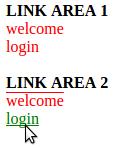<html>
<head>
<style type="text/css">
.typ1 A:link{text-decoration:none}
.typ1 A:visited{text-decoration:none; color: red}
.typ1 A:hover{text-decoration:underline; color:green}
.typ1 A:active{text-decoration:none; color:purple}
.typ2 A:link{text-decoration: overline}
.typ2 A:visited{text-decoration:overline; color: red}
.typ2 A:hover{text-decoration:underline; color:green}
.typ2 A:active{text-decoration:overline; color:purple}
</style>
</head>
<body>
<b> LINK AREA 1</b><br>
<span class="typ1">
<a href="color.html">welcome</a><br>
<a href="textcolor.html">login</a>
</span>
<br><br><b> LINK AREA 2</b><br>
<span class="typ2">
<a href="color.html">welcome</a><br>
<a href="textcolor.html">login</a>
</span>
</body>
</html>

<html>
<head>
<style type="text/css">
.emb{border: double; font-variant:small-caps; border-color: green;color:red; width:250px;}
</style>
</head>
<body>
<h2>Example of div element</h2>
<div class="emb">The div is a block level element</div>
</body>
</html>
